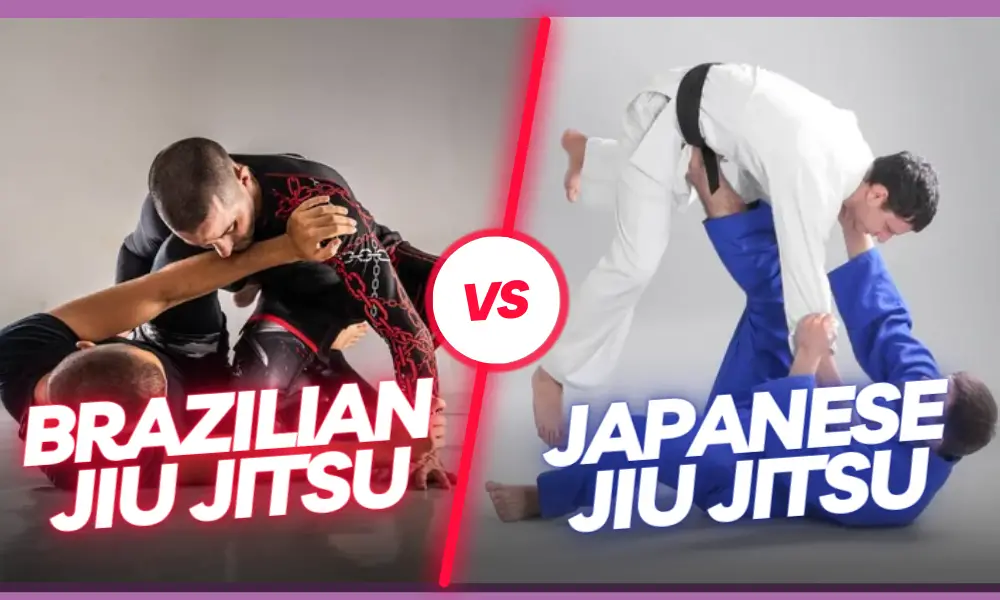Are you a fan of martial arts?
It’s the battle of the jiu jitsu styles!
Are you keen to know the difference between Brazilian Jiu Jitsu and Japanese Jiu Jitsu?
Look no further! This post is all about the history, methods, and philosophy of these two popular jiu jitsu styles.
No matter if you are a beginner or pro player you can always learn something new. So give this article a red.
Ready to roll?
Brazilian Jiu Jitsu vs Japanese Jiu Jitsu
BJJ and JJJ are distinct martial arts with different objectives. BJJ is a ground-based grappling system that emphasizes positional control, while JJJ is a more traditional martial art that includes striking, joint locks, throws, and weapons. BJJ is known for its effectiveness in MMA and self-defense, while JJJ values personal development and self-cultivation.

History of BJJ and Japanese Jiu Jitsu
Japanese Jiu Jitsu, also known as Jujutsu or Judo, has its roots in Japan and dates back to the 16th century.
It was primarily developed for samurai warriors to fight without weapons if they were disarmed or if their weapons were no longer available.
The techniques of Japanese Jiu Jitsu involve grappling, throwing, and joint locking, which is aimed at controlling and subduing the opponent.
On the other hand, Brazilian Jiu Jitsu was developed in Brazil in the early 20th century by the Gracie family, who had learned traditional Japanese Jiu Jitsu from a Japanese master.
The Gracies adapted the techniques to suit their smaller physiques and created their own unique style, which emphasized ground fighting and submissions.
Comparing BJJ and Japanese Jiu Jitsu
Ready for some mind-blowing content? Buckle up!
Fighting Styles
One of the primary differences between BJJ and Japanese Jiu Jitsu is their fighting styles.
Japanese Jiu Jitsu focuses on standing techniques like throws, takedowns, and strikes, while BJJ emphasizes ground fighting and submissions.
In BJJ, the goal is to take the opponent to the ground and submit them using joint locks or chokes.
Rules
Another significant difference is the rules. Japanese Jiu Jitsu has a wide range of techniques that can be used in training and competition, whereas BJJ has more strict rules.
In BJJ, you cannot strike your opponent, and some techniques like neck cranks and certain leg locks are not allowed in competition.
Uniform
The uniform, or gi, is also different in BJJ and Japanese Jiu Jitsu. In Japanese Jiu Jitsu, the gi is often thicker and more traditional in style, while in BJJ, the gi is thinner and more fitted, allowing for greater mobility and flexibility.
Techniques
Techniques like BJJ and Japanese Jiu Jitsu have techniques in common. The difference lies in the way of execution.
For example, Japanese Jiu Jitsu tends to use more circular movements, while BJJ uses more linear movements.
Additionally, BJJ places greater emphasis on ground fighting and submissions, while Japanese Jiu Jitsu places more emphasis on standing techniques.
Training and Competitions
Training methods and competition formats also differ between BJJ and Japanese Jiu Jitsu. In BJJ, rolling, or sparring, is an integral part of training, and competitions typically involve a bracket-style tournament with weight classes.
Japanese Jiu Jitsu training is more varied and may include kata, or pre-arranged forms, as well as live sparring. Competitions may vary in format and rules depending on the organization and style.

Which One Should You Choose?
Now, that’s a tricky one!
Choosing between BJJ and Japanese Jiu Jitsu ultimately depends on personal preference and goals.
If you are interested in ground fighting and submissions, BJJ may be the better choice for you.
And, if you are interested in a wider range of techniques and a more traditional approach to martial arts, Japanese Jiu Jitsu may be the better fit.
End words
In my opinion, whether you prefer BJJ or Japanese Jiu Jitsu, there’s no denying that both martial arts have a lot to offer.
In summary, BJJ and Japanese Jiu-Jitsu are two distinct martial arts styles with their own unique histories, techniques, and rules.
While both styles share many similarities, they also have significant differences in terms of fighting style, rules, uniform, and techniques.
The final choice depends on the player’s preferences. The player will be equipped with self-defense, discipline, and focus. It also enhances overall confidence and self-esteem. They also assist in community-building and teaching the importance of community and the code of conduct. The final words are that both BJJ or Japanese jiu-jitsu and has its own set of pros and scope of growth.
Exploring is what will help you to find the best fit in terms of style and techniques. Another thing about martial art is to have fun while learning. It is not always about competition but enjoying the process.

